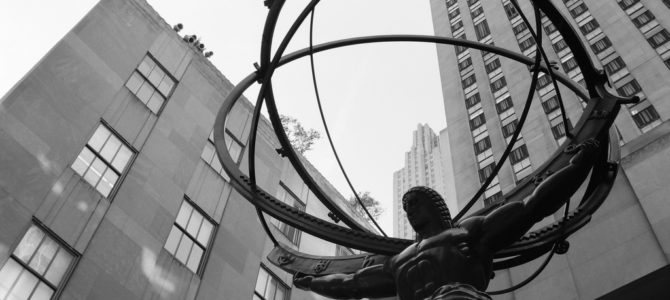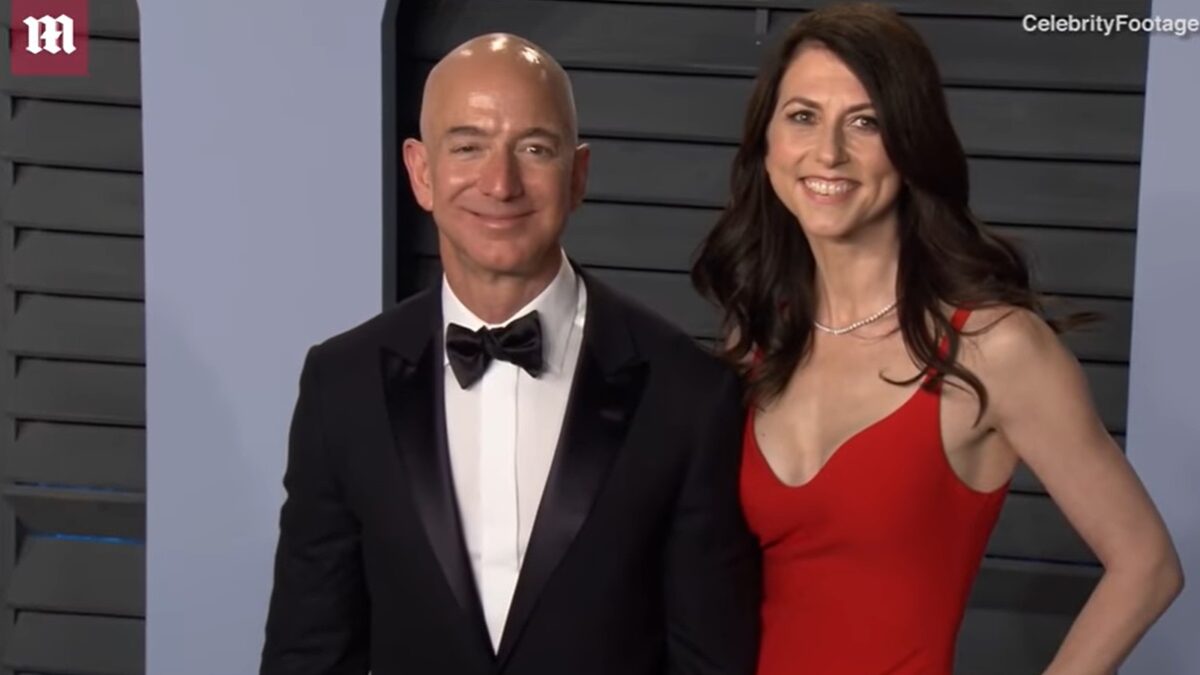
The New York Times recently published an article holding up Uber’s recently ousted CEO Travis Kalanick as a cautionary tale for Silicon Valley entrepreneurs who are influenced by Ayn Rand. The implication is that implementing Rand’s ideas in managing a business will lead to disaster.
This is not the first time we’ve heard this kind of argument, and it serves an obvious purpose. Critics of Rand know that her popularity among businessmen is a key part of her appeal. More broadly, they sense that the achievement of capitalism in continually transforming and improving human life—particularly in Silicon Valley, which is famous for giving us astonishing new products at ever-lower prices—provides a large-scale, real-world validation of key parts of her philosophy. So they have to come up with arguments, however thin, to show that Rand’s ideas are bad for business.
The evidence for such claims is very thin indeed. The New York Times article, for example, is ostensibly about Travis Kalanick and Uber, but it gives no real description of Kalanick’s management practices, aside from Silicon Valley rumors about Uber tolerating sexist behavior from its employees. It’s worth noting that Kalanick was forced out as CEO, not because of poor performance by his company, but because of a string of bad PR over the last year. Meanwhile, he spent much of the past decade shepherding Uber from a tiny startup to a company that has changed transportation in cities across the world and is worth more than $50 billion. Not exactly proof of management failure.
As I have discussed elsewhere, Uber is based on precisely the kind of disruptive business idea that Rand would have loved, particularly because it found a way to undermine irrational government regulations and break the local taxi monopolies. The company has gotten away with this because it offered so much value to so many people—including the urban, upper-middle-class types who would normally support government regulations, but who don’t want to give up their Ubers. I have sensed for a while now that some these customers are uncomfortable with the compromise, so they leaped at a chance to cover that gap between principles and practice by sacrificing Travis Kalanick for a reason that seems politically comfortably. That’s why you can color me skeptical about the notion that Kalanick was not a good CEO taken as a whole.
The same is true for the other examples in the article. Fast-food executive Andy Puzder is cited as an example of management failure because he was too controversial to be appointed to a cabinet post. John Mackey is cited because he “had to” sell Whole Foods to Amazon for nearly $14 billion—this, for a chain he co-founded as a single small store in Austin, Texas, in 1980. If only the rest of us could be so fortunate as to suffer such management failures.
Other claims have been a bit more substantive. A few years ago, some leftists were gloating that the slow-motion collapse of Sears, a venerable old retailer, was because its CEO, hedge-fund manager Eddie Lampert, was a fan of Ayn Rand who supposedly drew on her ideas for managing the company. Unfortunately for that thesis, there was in-depth reporting on how Lampert was actually running Sears. The overall theory might sound vaguely plausible at first.
Lampert runs Sears like a hedge fund portfolio, with dozens of autonomous businesses competing for his attention and money. An outspoken advocate of free-market economics and fan of the novelist Ayn Rand, he created the model because he expected the invisible hand of the market to drive better results. If the company’s leaders were told to act selfishly, he argued, they would run their divisions in a rational manner, boosting overall performance.
Then you look at it in more detail and see how this theory was implemented. As I wrote at the time:
In practice, all of this ends up being less Atlas Shrugged than ‘Game of Thrones.’ It’s a system of constant warfare among rival fiefdoms.
Ayn Rand celebrated the freewheeling entrepreneurs who acted on their own judgment and chafed at the inertia of entrenched bureaucracies. But Lampert’s system multiplies the bureaucracy. ‘[T]here were more than 30 slots to fill at the head of each unit. Executives jostled for the roles, each eager to run his or her own multibillion-dollar business. Marketing directors interviewed with the newly appointed presidents, hoping to snag coveted chief marketing jobs….
‘Because Sears had to hire and promote dozens of chief financial officers and chief marketing officers, personnel expenses shot up. Meanwhile, many business unit leaders underpaid middle managers to trim costs.
‘The most cumbersome aspect of the new structure, former employees say, was Lampert’s edict that each unit create its own board of directors. Because there were so many departments, some presidents sat on as many as five or six boards, which met once a month. Top executives were constantly mired in meetings.’
As for whether anyone can make a decision and just move on it, ‘If product divisions like tools or toys wanted to enlist the services of the IT or human resources departments, they had to write up formal agreements.’ So you have 30 separate divisions all trying to negotiate agreements with each other. It’s a nightmare of red tape.
Philosophically, Lampert’s error is childishly simple. At one point in Kimes’s report, a Lampert spokesman compares central management of a private company to ‘socialism.’ But this drops the basic distinction between coercive government action and uncoerced private action….
The business heroes in Ayn Rand’s novels all have one thing in common: they take seriously the responsibility of thinking and planning and making decisions. They know that they can’t pass the buck and that it is their job to set the direction for the companies they run. But Lampert’s system seems to be an attempt to evade that responsibility by pretending that decisions will somehow emerge spontaneously from an imaginary internal marketplace.
One former employee summed it up nicely: “Eddie’s Sears is not the free market, nor is it the Soviet central planning committee. It is the imperial court of Byzantium.”
But our concern here is not so much the merits or demerits of any particular CEO’s management style, which would depend on in-depth reporting about the company’s internal decision-making and a long-term consideration of its success. Our concern is with something we can assess more definitively: what can a fan of Rand’s work reasonably take from “Atlas Shrugged” as her views on management and running a business?
This, by the way, is the biggest error in the New York Times article. It quotes a sneering philosophy professor who says that Rand “never really explores how a dynamic entrepreneur actually runs a business.” Did he read the same book?
Business Is the Setting of Rand’s Books,and She Studied It
“Atlas Shrugged” is not a book about business and management, in the same way that “The Fountainhead” is not a book about architecture. Yet Rand ends up having an awful lot to say about both of those topics. Business and management is not the subject or theme of “Atlas Shrugged,” but it is the setting. As one of the few novelists to make a serious and sympathetic attempt to portray people who run businesses, she frequently sets up her characterization and plot points by showing us how the heroes and villains operate in the business world, how they make important decisions, and how they treat their employees.
We can look at that and derive a few basic rules for how an Ayn Rand hero does business. Call it “The Management Secrets of ‘Atlas Shrugged.'” After all, we’ve had a string of business books over the decades giving us supposed management secrets from a whole cavalcade of unlikely sources, from Sun Tzu and Machiavelli to Winnie the Pooh (yes, really). Recently, we’ve even been told about management secrets from “Game of Thrones”—corporate motto: “Chaos Is a Ladder“—which seems like a really terrible idea, considering how things tend to end up in that series. At least in the Winnie the Pooh books, everybody lives.
It’s time we took a look at management from the perspective of an author who actually cared about portraying the world of business and productivity. And she did not draw purely on her imagination as a writer. She had studied the history of capitalism, drawing on great American industrialists as the models for her heroes—as well as the business leaders she met up close in her career in Hollywood and the publishing business, from Cecil B. DeMille to Jack Warner to Bennett Cerf. She took those observations and sought to distill them into the characters and setting of her novel.
7 Management Secrets from ‘Atlas Shrugged’
So what can we learn from Ayn Rand about running a business? Here are the seven management secrets of Atlas Shrugged.
(Warning: In this overview, there will be plenty of “spoilers,” discussion of important plot points that will ruin the novel’s suspense for someone who does not already know how it all turns out. I don’t want any reader to find himself slapping his forehead in the middle of one of these articles and thinking: if only I hadn’t missed out on this experience that has now been wrecked for me. So take this spoiler warning seriously. I mean it.)
1. Know the business from the ground up.
Many of Ayn Rand’s business heroes are self-made men who worked their way up from the bottom, starting with the lowest, grittiest entry-level jobs in their industries. Hank Rearden rose up out of the iron mines before becoming a mine owner, then the owner of multiple iron and coal mines, then a steel tycoon.
He saw the day when he stood on a rocky ledge and felt a thread of sweat running from his temple down his neck. He was fourteen years old and it was his first day of work in the iron mines of Minnesota. He was trying to learn to breathe against the scalding pain in his chest. He stood, cursing himself, because he had made up his mind that he would not be tired. After a while, he went back to his task; he decided that pain was not a valid reason for stopping.
He saw the day when he stood at the window of his office and looked at the mines; he owned them as of that morning. He was thirty years old. What had gone on in the years between did not matter, just as pain had not mattered. He had worked in mines, in foundries, in the steel mills of the north, moving toward the purpose he had chosen.
The same goes for Ken Danagger, who is described as having started work in the coal mines at age 12—this was before the era of modern child labor laws.
Even the heroes who inherited successful companies learned the ropes by starting out—sometimes surreptitiously—at low-level jobs. At age 16, railroad heiress Dagny Taggart starts a summer job as the night operator at a rural train station. Francisco D’Anconia, heir to a vast copper fortune, spends his college years working at a dilapidated copper foundry, which he then buys with money he earned by speculating on stocks in his spare time. (If this strikes you as over the top, that’s the whole point of Francisco’s character.)
In one memorable scene, this is the bond that seals the friendship between the ultimate self-made man, Rearden, and the world’s richest heir, D’Anconia: the fact that they both know an obscure and long-forgotten method for sealing a furnace breach by hand.
In the few moments which Rearden needed to grasp the sight and nature of the disaster, he saw a man’s figure rising suddenly at the foot of the furnace, a figure outlined by the red glare almost as if it stood in the path of the torrent, he saw the swing of a white shirt-sleeved arm that rose and flung a black object into the source of the spurting metal. It was Francisco d’Anconia, and his action belonged to an art which Rearden had not believed any man to be trained to perform any longer.
Years before, Rearden had worked in an obscure steel plant in Minnesota, where it had been his job, after a blast furnace was tapped, to close the hole by hand—by throwing bullets of fire clay to dam the flow of the metal. It was a dangerous job that had taken many lives; it had been abolished years earlier by the invention of the hydraulic gun; but there had been struggling, failing mills which, on their way down, had attempted to use the outworn equipment and methods of a distant past. Rearden had done the job; but in the years since, he had met no other man able to do it. In the midst of shooting jets of live steam, in the face of a crumbling blast furnace, he was now seeing the tall, slim figure of the playboy performing the task with the skill of an expert.
This is why the heroes in “Atlas Shrugged” are able to start up again in Galt’s Gulch. They have given up their large corporations and are starting over on a small scale, with relatively little capital. But they have not given up their knowledge of how a business works. They can readily downshift into the roles of foremen and mechanics, and they have no compunction about walking to work swinging a lunchbox.
The important contrast here is between Dagny and her brother, Jim. He is always demanding the impossible and the contradictory, as in the Taggart Tunnel disaster, when he demands that Kip Chalmers be given a train to get him to California on time, but also that it be done safely—goals that are mutually exclusive. He views it as his job to give vague and peremptory orders and somebody else’s job to figure out how to make it work. He expects it to happen “somehow,” because he doesn’t know or want to know the details of how his company operates. He started his career on the railroad in the PR Department, and as one of Rearden’s men later puts it, he’s the type who is only good at running to Washington, not running his business.
All of Rand’s business heroes share a core of competence based on experience that keeps them in touch with the day-to-day operation of their businesses. This also earns them the admiration and support of their employees, because they know that the guy (or gal) in the executive office knows what he’s doing. Which leads us to the next management secret.
2. Earn respect.
In the very first scene where we meet our main protagonist, Dagny Taggart, we see her give decisive orders to solve a problem that’s causing her railroad’s flagship passenger train to fall behind schedule. After she gives that order, one of the newer railroad workers asks someone who she is. Here is the reply: “‘That’s who runs Taggart Transcontinental,’ said the engineer; the respect in his voice was genuine.” And later: “When she went out on the line, old railroad men, who hated Jim, said, ‘There will always be a Taggart to run the railroad,’ looking at her as her father had looked.”
When we first meet Hank Rearden, he is watching his workers pouring the first heat of Rearden Metal, and we get a sense of the camaraderie he shares with them: “A worker saw him and grinned in understanding, like a fellow accomplice in a great celebration, who knew why that tall, blond figure had had to be present here tonight. Rearden smiled in answer: it was the only salute he had received.”
Rand’s heroes are clearly inspirational leaders, but it’s not because they jet off to Davos or give TED talks about “thinking outside the box” or make pie-in-the-sky promises about putting a million people on Mars. It’s because they earn the respect of their employees and business partners.
There is nothing worse than working for a boss who doesn’t know the difference between your best work and somebody else’s worst, or who constantly has to be talked out of bad ideas because he doesn’t know any better. That’s what working for Jim Taggart is like, and it’s what Dagny feels while working her way up under one of Jim’s cronies.
She was defeated by loathing for the hours, the days, the nights she had to waste circumventing the interference of Jim’s friend who bore the title of Vice-President in Charge of Operation. The man had no policy, and any decision he made was always hers, but he made it only after he had made every effort to make it impossible.
Or consider Gerald Starnes, one of the failed heirs of the Twentieth Century Motor Company. Jeff Allen describes how, as director of production, Starnes led VIP tours of the factory and collected the magazine covers he appeared on, while being blithely unconcerned with the actual day-to-day running of the company—and how this earned him the contempt of the men on the factory floor.
Rand’s heroes inspire their employees because they lead from the front. They never demand that anyone give more, in terms of knowledge, work, or devotion, than they give themselves.
3. Always take responsibility.
In another installment of this series, I described Dagny Taggart Mode, her characteristic way of dealing with a business problem: “The basic pattern goes like this: somebody rushes in to report an emergency, saying, ‘Miss Taggart, we don’t know what to do.’ Dagny immediately assesses the situation, comes up with a solution, and starts giving orders. At some point somebody asks who’s going to be responsible for giving the orders, and she says, ‘I will.'”
This is probably what stands out most about Dagny’s approach to her work, and you can see how it ties in to the wider themes and conflicts of the novel. She is the kind of person who habitually takes on responsibility, and she’s used to making good on it. So you can see why she keeps on believing, almost to the end, that she can single-handedly save the world.
Similarly, when Mr. Ward of the Ward Harvester Company comes to Hank Rearden attempting to place an order for steel, he explains that Orren Boyle’s Associated Steel has been promising him a delivery any week now—for a year. He then says he’s come to Rearden because he is “the only decent—I mean, reliable—steel manufacturer left.” Note the very deliberate implication that being a reliable business partner, one who honors his promises, is the same thing as being morally “decent.”
This is one of the reasons why the business heroes in “Atlas Shrugged” all have their businesses named after them—Rearden Steel, D’Anconia Copper, Wyatt Oil, Taggart Transcontinental—while the villains run companies with vaguely collective names like Associated Steel. Part of the point Rand was making is that behind every productive organization there is a person who created it and keeps it going. But from the characters’ perspective, they name their businesses after themselves as a way of stressing their responsibility, the idea that everything their company does is literally done in their name.
(I can’t help pointing out, in this context, the very different spirit of a major business figure in today’s culture who likes to put his name on everything. Donald Trump is notorious for lending his name to a string of marginal and dubious ventures: failed attempts at celebrity branding (Trump water and Trump steaks), bogus real-estate investment seminars (Trump University), and overseas hotels that he doesn’t run and for which he hasn’t put up any capital. Trump names things after himself, not out of a sense of responsibility, but out of vanity—and in a cheap attempt to cash in on his notoriety.)
The whole method of the business villains in “Atlas Shrugged” is to evade responsibility, constantly whining that “it wasn’t my fault,” or “I can’t be blamed.” We can see this most clearly in the Taggart Tunnel disaster, which happens because, with Dagny briefly gone, a whole chain of Taggart executives from Jim on down pass the buck.
Dave Mitchum was not good at understanding problems of engineering and transportation, but he understood men like Clifton Locey. He understood the kind of game the New York executives were playing and what they were now doing to him. The order did not tell him to give Mr. Chalmers a coal-burning engine—just “an engine.” If the time came to answer questions, wouldn’t Mr. Locey gasp in shocked indignation that he had expected a division superintendent to know that only a Diesel engine could be meant in that order? The order stated that he was to send the Comet through ‘safely’—wasn’t a division superintendent expected to know what was safe?—’and without unnecessary delay.’ What was an unnecessary delay? If the possibility of a major disaster was involved, wouldn’t a delay of a week or a month be considered necessary? The New York executives did not care, thought Mitchum; they did not care whether Mr. Chalmers reached his meeting on time, or whether an unprecedented catastrophe struck their rails; they cared only about making sure that they would not be blamed for either.
In turn, Mitchum finds a way to pass the buck all the way down to the most junior employee in the operation, with disastrous results.
This is why you will find that businessmen who are influenced by “Atlas Shrugged” often cite things like “honesty” and “integrity” as lessons they took from the book. Oh, what a nefarious influence—businessmen who believe in integrity! But that’s because this is the actual, practical reality of how her heroes live and run their businesses.
4. Deal with the best talent.
If Ayn Rand’s heroes expect a lot out of themselves, they look for the same qualities in the people they hire and do business with.
At the beginning of the novel, the basic plot idea is introduced to us in the form of Dagny’s struggle to find and retain talent. One of the first things she does is to offer Owen Kellogg a promotion to replace an incompetent manager, then attempt to keep him when he says he’s quitting. Why?
She knew that the superintendent of the Ohio Division was no good and that he was a friend of James Taggart. She had not insisted on throwing him out long ago only because she had no better man to put in his place. Good men were so strangely hard to find. But she would have to get rid of him, she thought, and she would give his post to Owen Kellogg, the young engineer who was doing a brilliant job as one of the assistants to the manager of the Taggart Terminal in New York; it was Owen Kellogg who ran the Terminal. She had watched his work for some time; she had always looked for sparks of competence, like a diamond prospector in an unpromising wasteland. Kellogg was still too young to be made superintendent of a division; she had wanted to give him another year, but there was no time to wait.
Later, in Galt’s Gulch, Dagny realizes that the foreman at Andrew Stockton’s foundry is the disappeared coal tycoon Ken Danagger.
She glanced at Stockton with curiosity. ‘Aren’t you training a man who could become your most dangerous competitor?’
That’s the only sort of men I like to hire…. Any man who’s afraid of hiring the best ability he can find is a cheat who’s in a business where he doesn’t belong.
Or consider Midas Mulligan, the banker whose touch turns everything to gold, and how he describes the secret of his financial success.
I was born on a farm. I knew the meaning of money. I had dealt with many men in my life. I had watched them grow. I had made my fortune by being able to spot a certain kind of man. The kind who never asked you for faith, hope and charity, but offered you facts, proof and profit.
The idea of “a certain kind of man,” of a code of rationality and competence, runs through the worldview of Rand’s business heroes. The importance of men of ability, and what happens in an organization or society where they are not welcome, are not the abstract philosophical themes of the novel. They’re a recurring concern of all the major characters. John Galt coins another metaphor for this outlook.
I went out to become a flame-spotter. I made it my job to watch for those bright flares in the growing night of savagery, which were the men of ability, the men of the mind—to watch their course, their struggle and their agony—and to pull them out, when I knew that they had seen enough.
Unlike Dagny, Galt isn’t trying to keep the railroad or the nation’s economy together. He’s trying to pull them down. But his description of his method serves as a guide for what Rand’s business heroes are trying to do to build up their companies.
The manager who is influenced by “Atlas Shrugged” is, above all else, a flame-spotter who is constantly on the lookout for talent, competence, and rationality, and he’s always looking to elevate talented individuals to the highest level of work they’re capable of.
5. Set an innovative vision.
Rand’s business heroes are also trying to elevate their companies to a higher and higher level. They are not mere caretakers trying to administer an established organization and make sure it runs smoothly, or trying to eke out a marginal extra profit from a proven business model. They are visionaries who are looking for revolutionary new machines and the kind of innovations we would describe nowadays as “disruptive.”
There are two such disruptive innovations that embody this idea. Roughly the first third of the novel’s plot is driven by Hank Rearden’s invention of a revolutionary metal alloy that is strong, lighter, cheaper, and longer-lasting than steel. In fact, the plot of the novel is kicked off by two business conferences in the first chapter. In the first, Eddie Willers informs James Taggart of a freight train derailment and warns him of the disastrous state of the Taggart system’s rail, particularly in the Rio Norte Line in Colorado. In the second conference, Dagny tells Jim that she has ordered new rail that will be made of Rearden Metal—and dares him to cancel the order.
The metal itself is Rearden’s visionary idea. Using it to rebuild the Rio Norte Line is Dagny’s innovative vision. She is an early adopter, pushing Taggart Transcontinental to embrace a new material that everyone else still considers risky and untested.
Dagny’s crucial idea is that innovation can be her company’s way of surviving an economic downturn. With the nation’s economy in crisis, Jim’s reflex—as usual—is to hunker down, to be safe and cautious and do things in the established way. This is one of the things that makes Jim Taggart such a bad manager: his mania for wanting to make everything stand still, so he can go through the motions of running his business the way the people before him ran it, collecting all the same prestige without having to do any new thinking.
By contrast, Dagny understands that a Rio Norte Line made of Rearden Metal, serving the booming new businesses of Colorado, would generate profits that could be used to rebuild and revitalize the whole Taggart system—which, in turn, could help revitalize the nation’s entire economy. This innovative business vision drives everything in the first third of the novel. It’s what motivates her to separate from Taggart Transcontinental to build the John Galt Line, it’s what forges her connection with Ellis Wyatt and the other business leaders of Colorado, and it’s what draws her and Hank Rearden together.
By the end of Part One of the novel, however, they’ve proven their point. Rearden Metal is now regarded as a proven technology that is rapidly being adopted by others. In a gimlet-eyed and totally accurate view of the natural life cycle of a new technology, Rearden Metal will eventually go from being an unproven, pie-in-the-sky idea to an everyday product so thoroughly taken for granted that it is claimed by everyone as a universal entitlement and regulated by the government as a public utility. In other words, exactly the same process that is behind Net Neutrality.
Naturally, having proven one new technology, it is time for our innovators to move on to the next big thing, which is the revolutionary motor they find abandoned at the Twentieth Century Motor Company. What could be more “disruptive” than a motor that draws unlimited amounts of electricity from the atmosphere? The search for the motor drives the plot up through the end of Part Two and brings us into Part Three. Remember that Dagny crash-lands in the Valley because she is chasing Quentin Daniels, the researcher she hired to unravel the motor’s secrets.
So the business leader’s search for innovation is at the heart of the novel and is the key driver of the plot.
6. Make every deal win-win.
This is a point that very few of the casual mainstream commentators get. In fact, it’s the opposite of what they always try to imply when they claim Rand’s ideas are bad for business. Because the Ayn Rand-inspired businessman is out for his own selfish gain, they assume, therefore he will naturally alienate others by seeking to profit at their expense.
If you actually read “Atlas Shrugged,” you notice that her heroes are very insistent on making mutually beneficial deals and never trying to get something for nothing out of the their customers or business partners. They expect the other guy to pull his weight in any business deal—and they expect that they will have to provide a lot of value in return.
Consider what happens when Dagny shows Rearden the list of investors in the John Galt Line.
He reached for his fountain pen, wrote at the bottom of the list ‘Henry Rearden, Rearden Steel, Pennsylvania—$1,000,000’ and tossed the list back at her.
‘Hank,’ she said quietly, ‘I didn’t want you in on this. You’ve invested so much in Rearden Metal that it’s worse for you than for any of us. You can’t afford another risk.’
‘I never accept favors,’ he answered coldly.
‘What do you mean?’
‘I don’t ask people to take greater chances on my ventures than I take myself. If it’s a gamble, I’ll match anybody’s gambling. Didn’t you say that that track was my first showcase?’
She inclined her head and said gravely, ‘All right. Thank you.’
‘Incidentally, I don’t expect to lose this money. I am aware of the conditions under which these bonds can be converted into stock at my option. I therefore expect to make an inordinate profit—and you’re going to earn it for me.’
Rand’s heroes don’t mind driving a hard bargain—but if they make a big profit, they expect to have earned it. You see the same pattern in her negotiations with Quentin Daniels over his work on Galt’s motor.
She protested, in astonishment, against the low monthly salary he quoted. ‘Miss Taggart,’ he said, ‘if there’s something that I won’t take, it’s something for nothing. I don’t know how long you might have to pay me, or whether you’ll get anything at all in return. I’ll gamble on my own mind. I won’t let anybody else do it. I don’t collect for an intention. But I sure do intend to collect for goods delivered. If I succeed, that’s when I’ll skin you alive, because what I want then is a percentage, and it’s going to be high, but it’s going to be worth your while.’
When he named the percentage he wanted, she laughed. ‘That is skinning me alive and it will be worth my while. Okay.’
Likewise, when Rearden tells a reporter that “I expect to skin the public to the tune of a profit of twenty-five per cent in the next few years,” a reporter responds, “If it’s true, as I’ve read in your ads, that your Metal will last three times longer than any other and at half the price, wouldn’t the public be getting a bargain?” Rearden replies: “Oh, have you noticed that?”
It is the government officials and the altruistic “humanitarians” who keep trying to set up deals in which one side gets all the benefits and the other side takes all the losses. That’s how Jim gets Taggart Transcontinental into the San Sebastian boondoggle, which the socialist “People’s State” in Mexico intends to nationalize from the very beginning. Or consider the Steel Unification Plan that Rearden is pitched toward the end of the novel, in which the revenues generated from his steel mills will be used to prop up his competitors.
Rand makes a specific point to show why these one-sided altruist set-ups have to fail. If you create a deal in which one side takes all the burdens and all the losses, you are ensuring that one of the parties to the deal will eventually be unable to fulfill its obligations and the whole thing will collapse. Here’s how Rearden puts it as he considers the Steel Unification Plan.
You consider me of invaluable importance to the country? Hell, you consider me of invaluable importance even to your own necks…. Yet you propose a plan to destroy me, a plan which demands, with an idiot’s crudeness, without loopholes, detours or escape, that I work at a loss—that I work, with every ton I pour costing me more than I’ll get for it—that I feed the last of my wealth away until we all starve together.
This rule of management is codified by John Galt as the basic rule by which people should deal with one another: mutually beneficial trade. “We, who live by values, not by loot, are traders, both in matter and in spirit. A trader is a man who earns what he gets and does not give or take the undeserved.” In her non-fiction works, she would go on to add that “The principle of trade is the only rational ethical principle for all human relationships, personal and social, private and public, spiritual and material. It is the principle of justice.”
That brings us to the final management lesson from “Atlas Shrugged.”
7. Don’t prop up the Jim Taggarts.
This is shown in “Atlas Shrugged,” not by the positive example of her main protagonists, but by their biggest error.
In taking heroic action intended to save the railroad and the economy, Dagny actually ends up bailing out her worthless brother, time and time again. Consider her policy toward the San Sebastian Line, in which she anticipates the Mexican nationalization and brings as many objects of value back across the border as possible, cushioning the blow to the railroad. But what is the actual effect of that action? Jim gives a triumphant speech to the board of directors taking credit for her policy, buying him a reprieve from the consequences of his own decisions.
This is even clearer in the aftermath of the Taggart Tunnel disaster. Jim is shown staring at his letter of resignation and waffling about whether to sign it. He then storms over to Dagny’s office to blame Eddie Willers for her absence. When she suddenly returns and goes back to work, what does Jim do? “Like a paralytic, uncertain of his muscles’ obedience, he gathered his strength and slipped out. But he was certain of the first thing he had to do: he hurried to his office to destroy his letter of resignation.”
This isn’t about claiming credit or public glory. This is about not accepting a role as the person who always bails his boss, colleagues, or business partners out of their own mistakes, putting them in the position to make more mistakes that need more bailing out in the future.
This is a principle that has actually won a certain degree of acceptance in cases involving addiction to drugs and alcohol. In the current therapeutic terminology, the person who always bails a chronic drunk out of trouble is “codependent” or an “enabler,” the person who allows the addict to keep functioning when the best thing is to allow him to hit rock bottom, in the hope that he will eventually choose to confront his own problem.
Dagny’s dilemma is that she also has to let Taggart Transcontinental hit rock bottom. In a world different than the one we are shown in the novel, she might have saved her railroad by quitting and let Jim’s misadventures crash the Taggart stock, then swooping in to lead a hostile takeover backed by Midas Mulligan. She could have been the ultimate “activist investor” ousting an incompetent CEO—and don’t believe for a moment that she couldn’t have done it. But that would be a very different novel with a very different theme. More to the point, it would require that Dagny (and many other people) had already learned the lessons that they spend most of “Atlas Shrugged” learning.
Hank Rearden illustrates a variation on this lesson. What he learns is never to apologize for the productive core of his business. An Ayn Rand hero would certainly apologize for a genuine mistake, and they do so at various points in the novel. But they learn not to apologize for only hiring the most competent people, for seeking to make a profit, or for outperforming competitors. Such apologies are another form of enabling. They don’t appease the resentment of the novel’s villains; they feed it.
This is the opposite of the public relations advice a businessman is likely to get these days. Since we started by talking about Travis Kalanick and Uber, it’s worth noting that Uber has a history of hiring left-leaning PR experts, such as Barack Obama’s former campaign manager David Plouffe, to represent it. Yet when the whispering campaign against Kalanick built up, that’s the wing of the company that helped throw him under the bus. Maybe there’s a lesson in there that he should have learned from Ayn Rand and didn’t.
So Rand did have a few things to say about management, after all. It is not the real subject of “Atlas Shrugged,” but neither is it incidental to the novel. Ayn Rand uses the business decisions of her heroes as a way of moving forward the plot and characterization and of expressing her big philosophical themes. We wouldn’t know who Dagny Taggart is if we didn’t see her in Dagny Taggart Mode, swinging decisively into action and taking responsibility for solving problems.
We wouldn’t see the conflicts building in the world of the novel if we didn’t see her characters battling over the adoption of innovations like Rearden Metal and Galt’s motor. We wouldn’t appreciate Rand’s theme about the role of the individual if we didn’t see her protagonists struggling to hire and retain talent. And it would be harder to grasp the distinctive content of her moral philosophy if her heroes didn’t embody the “trader principle” (as it is called among advocates of her philosophy) and reject deals in which one side is expected to sacrifice.
Observers of the business world can debate how well these management ideas work and which companies and CEOs truly implement them. There are certainly some whose interest in her books is superficial. As a friend once put it to me, there are some businessmen who want to “Mary Sue” themselves as Hank Rearden—a term borrowed from Star Trek fan fiction in which the author seeks to write him- or herself into their favorite stories in an unrealistically self-flattering way.
But given the sheer number of her fans in the business world, including many people who have been very successful—as opposed to the few cherry-picked counter-examples you tend to get in articles like that New York Times piece—I expect that you would find her influence has been very beneficial and has helped unleash a lot of productive talent.
At the very least, there is no need to speculate on what she really had to say about how to manage a business. It’s right there, front and center, throughout the novel. The management secrets of “Atlas Shrugged” are not such a big secret after all.
Follow Robert on Twitter.









